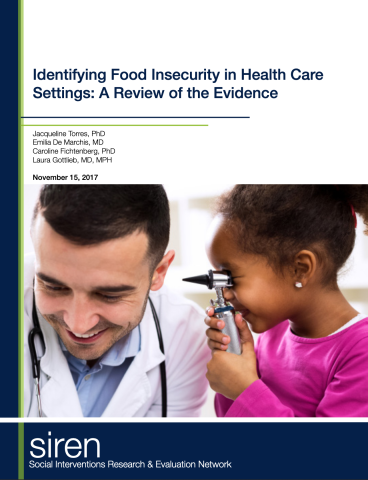Food insecurity (FI), or the limited access to adequate food due to a lack of money or other resources, is associated with poor health across the life-course. Spurred by this knowledge, and incentivized by recent health care payment reforms that reward keeping patients healthy, health systems around the country have been exploring ways to screen patients for FI and help food insecure patients access food resources. To inform these efforts, this report summarizes the research evidence published between January 2000 and June 2017 about health care-based screening for FI. A future report will examine research evidence on interventions to address FI in health care settings.
Multiple brief (one- and two-item) FI screening tools have been used and tested in health care settings and were reported to add minimal time burden for health care providers. There was incomplete overlap between patients reporting FI and the desire for assistance with food needs, however, raising questions about whether screening for FI should be complemented or replaced by screening for patient desire for assistance with food needs.
Studies exploring the patient and provider acceptability of FI screening were mixed. Most studies reported that patients were comfortable being asked about FI and that even being asked about social needs could make patients feel cared for by their providers. In other instances, patients and their caregivers indicated that FI is a sensitive issue, in particular for caregivers who might fear being reported to social services if they endorsed not being able to feed their children. This fear appeared to be alleviated by reassurance that providers were asking about FI in order to be able to help address FI and related social needs.
Providers expressed willingness to screen for FI, although in the absence of training both on how to conduct FI screening and on strategies for addressing identified FI, screening rates were low. Several studies described interventions to increase screening, including social screening curricula and observations and feedback around social history taking, which improved provider comfort with FI screening, perceived competence in addressing FI, and overall screening rates. The majority of the work on the validity of FI screening tools and on patient and provider acceptability in this field was conducted in pediatric populations.
More rigorously conducted research is needed to examine FI screening feasibility, acceptability, and interventions to improve screening rates across multiple settings and patient populations. No research identified in this review examined differences across the workforce engaged to conduct screening activities or ideal screening frequency, which may be important, given that household economic conditions and access to food-related benefits are likely to change over time.
Watch the recorded webinar & download the slides.
